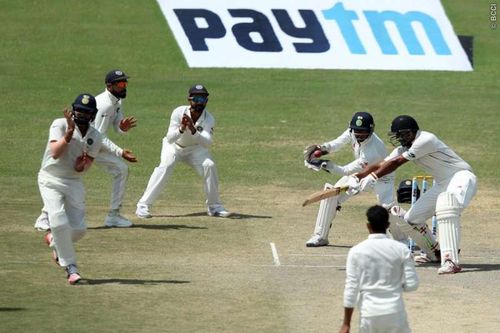
Why Kanpur can serve as the model for pitch curators in India

Ravichandran Ashwin had a painful corn on his right middle finger, going into the first Test between India and New Zealand. However, by the time it ended, his bowling figures told a different story – 6/132 in the innings to complete a 10-wicket haul in the match. It was his 19th five-wicket haul in 37 Tests.
To put that into perspective, Anil Kumble had managed 35 in 132 Tests and Kapil Dev had taken 23 in 131. This was Ashwin’s fifth 10-wicket haul – the same number as Harbhajan Singh’s 103 matches long career yielded.
Is this man even mortal? Or is it the pitches he’s been bowling on?
Also read: 5 variations in Ravichandran Ashwin's bowling
Honestly, quite a few tracks that Ashwin has feasted on in the last few years have been rank turners. That, however, does not take much away from the talented off-spinner. An oft-unacknowledged fact is that he has been reasonably successful even on surfaces that are not entirely conducive to spin right from the beginning.
Take the instance of the Kanpur pitch. A slow, turning surface, but it certainly wasn’t a nightmare for batsmen. Would it suit the criteria for an ideal Test match pitch? That, in turn, begs the question: What is an ideal Test match pitch anyway?
The ‘ideal’ surface
Opinions differ as regards to the details, but the general illustration suggests that an ideal pitch is one which offers something to the faster bowlers during the first couple of hours in the morning, turns into a batting heaven on the second and third day, and begins to aid the spinners on the fourth onward, possibly resulting in a good number of wickets towards the end.
Let’s now consider the Kanpur track that hosted India’s 500th Test. It was dry and cracked, but the curator had stressed before the game that the binding quality of the soil in this part of the world was astonishingly good. As it turned out ultimately, the strip was slow and there was that odd bounce every once in a while, but nothing the batsmen were incapable of handling.
If they applied themselves, that is. This is precisely what the surface demanded – proper application. Murali Vijay, Cheteshwar Pujara, Luke Ronchi and Mitchell Santner were patient and hence, reaped the dividends of application. There was turn, but as Ashwin remarked, it was slow enough for batsmen to adjust accordingly.
The argument about doctoring pitches
There will always be an element of vicious spin on the fifth day in Indian conditions. To argue that India is unfairly exploiting home conditions by ‘doctoring’ pitches is to exercise hypocrisy while living in denial. Every country – be it England or South Africa – is doing it, and there is nothing ‘unfair’ about the practice at all, as long as the curators know where to draw the line.
Nagpur and Mohali in the last season were extremes, as was the Green Park strip in 2008 that ultimately ended up being labeled ‘poor’ by the ICC. At Nagpur, the cracks were already loose by the time the Test began. At one point, it had almost come down to surviving the pitch rather than surviving the bowlers.
On the other hand, the 22 yards that greeted Kane Williamson’s men this September held firm and refused to provide any sort of help to the slower bowlers in the first two days. It was a traditional Indian pitch with the right amount of precursor ingredient for both the batsmen as well as the bowlers. All they had to do was to execute their plans to perfection.
And of course, there was that indication of reverse swing as well. Fortunately for India, Mohammed Shami is one of the finest exponents of the art under such heavy conditions. On the contrary, the New Zealand bowling department appeared terribly one-dimensional even with the likes of Trent Boult at their disposal.
Is Kanpur the way forward?
With as many as 10 more home Tests to go in this season, a relevant question that arises is: Is Kanpur the kind of track India should be looking to prepare?
There is certainly no point in having either an overtly green surface or a dustbowl at home. Flat tracks are unwelcome simply for the fact that they eliminate the excitement from Test cricket. Rank turners aren’t a prudent solution either, for Indian batsmen have repeatedly been found to be susceptible against capable spinners.
They struggled against Moeen Ali and Nathan Lyon in 2014-15 till Rangana Herath tore them apart at Galle last year. More recently, the Indians were bundled up for 79 against Santner and Co. in the 2016 T20 World Cup.
Further, consistent seam and bounce are unrealistic expectations on Indian soil. That leaves us with the kind of wicket Kanpur offered – encouraging to batting in the first couple of days, after which it was down to the spinners to work hard and earn their scalps. It was a proper Test pitch that could only be championed with skills, technique, and temperament.
In recent years, Test series’ in India have spanned the entire winter months and occasionally stretched to early summer. The weather, therefore, has had a lot of influence on the nature of the pitches. In regards to the team’s future schedule, this factor must assume importance while planning the watering and covering of tracks in the next few months.
It’s difficult to say whether Kanpur is closest to the notion of ‘ideal’ pitches that India has to offer, but it is undoubtedly one of the better surfaces to have welcomed the dueling teams in recent times.
Unless other venues turn out to be superior in quality, the Green Park strip should serve as the model for Indian curators in the coming months.